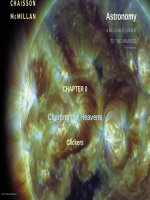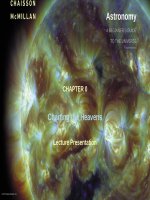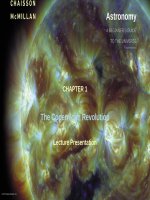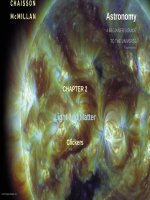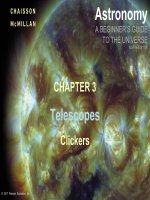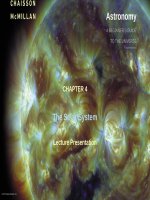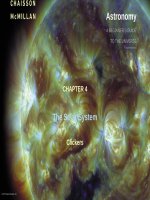Astronomy a beginners guide to the universe 8th CHaisson mcmillan chapter 08
Bạn đang xem bản rút gọn của tài liệu. Xem và tải ngay bản đầy đủ của tài liệu tại đây (4.99 MB, 39 trang )
Astronomy
A BEGINNER’S GUIDE
TO THE UNIVERSE
EIGHTH EDITION
CHAPTER 8
Moons, Rings, and Plutoids
Lecture Presentation
© 2017 Pearson Education, Inc.
Chapter 8 Moons, Rings, and Plutoids
© 2017 Pearson Education, Inc.
Units of Chapter 8
•
•
•
•
•
•
The Galilean Moons of Jupiter
The Large Moons of Saturn and Neptune
The Medium-Sized Jovian Moons
Planetary Rings
Beyond Neptune
Summary of Chapter 8
© 2017 Pearson Education, Inc.
8.1 The Galilean Moons of Jupiter
•
All four Jovian planets have extensive moon systems, and more are continually being
discovered.
•
The Galilean moons of Jupiter are those observed by the astronomer Galileo in 1610: Io,
Europa, Ganymede, and Callisto.
© 2017 Pearson Education, Inc.
8.1 The Galilean Moons of Jupiter
•
This image shows Jupiter with two of its Galilean moons.
© 2017 Pearson Education, Inc.
8.1 The Galilean Moons of Jupiter
•
The Galilean moons and their orbits
© 2017 Pearson Education, Inc.
8.1 The Galilean Moons of Jupiter
•
Their interiors
© 2017 Pearson Education, Inc.
8.1 The Galilean Moons of Jupiter
•
Io is the densest of Jupiter’s moons, and the most geologically active object in the solar
system.
–
–
–
It has many active volcanoes, some quite large.
Io can change surface features in a few weeks.
Io has no craters; they fill in too fast. Io has the youngest surface of any solar system object.
© 2017 Pearson Education, Inc.
8.1 The Galilean Moons of Jupiter
•
Io is very close to Jupiter and also experiences gravitational forces from Europa. The tidal
stretching is huge, and provides the energy for the volcanoes.
© 2017 Pearson Education, Inc.
8.1 The Galilean Moons of Jupiter
•
Europa has no craters; surface
is water ice, possibly with liquid
water below.
•
Tidal forces stress and crack ice;
water flows, keeping surface
relatively flat.
© 2017 Pearson Education, Inc.
8.1 The Galilean Moons of Jupiter
•
•
Ganymede is the largest moon in the solar system—larger than Pluto and Mercury.
It has a history similar to Earth’s Moon, but with water ice instead of lunar rock.
© 2017 Pearson Education, Inc.
8.1 The Galilean Moons of Jupiter
•
Callisto is similar to Ganymede but with heavy cratering and no evidence of resurfacing
activity.
© 2017 Pearson Education, Inc.
8.2 The Large Moons of Saturn and Neptune
•
Titan has been known for many years to
have an atmosphere thicker and denser
than Earth’s;
mostly nitrogen and argon.
•
Titan’s cloudy atmosphere makes it
impossible to see the surface; the picture
at
right was taken from only 4000 km away.
© 2017 Pearson Education, Inc.
8.2 The Large Moons of Saturn and Neptune
•
Infrared image of Titan, showing detail
and possible icy volcano.
•
There are few craters, consistent with
active surface.
•
Complex chemical interactions occur in
atmosphere.
© 2017 Pearson Education, Inc.
8.2 The Large Moons of Saturn and Neptune
•
The Huygens lander took these images of the surface of Titan.
© 2017 Pearson Education, Inc.
8.2 The Large Moons of Saturn and Neptune
•
Trace chemicals in Titan’s
atmosphere make it chemically
complex.
© 2017 Pearson Education, Inc.
8.2 The Large Moons of Saturn and Neptune
•
Triton is in a retrograde orbit; its surface
has few craters, indicating an active
surface.
•
Nitrogen geysers have been observed on
Triton, contributing to the surface
features.
© 2017 Pearson Education, Inc.
8.3 The Medium-Sized Jovian Moons
•
Densities of these moons suggest that they are rock and water ice.
© 2017 Pearson Education, Inc.
8.3 The Medium-Sized Jovian Moons
•
•
Moons of Saturn, in natural color
Note the similarities, as well as the large crater on Mimas.
© 2017 Pearson Education, Inc.
8.3 The Medium-Sized Jovian Moons
•
Moons of Uranus and Neptune
© 2017 Pearson Education, Inc.
8.3 The Medium-Sized Jovian Moons
•
Miranda shows evidence of a violent past, although the origin of the surface features is
unknown.
© 2017 Pearson Education, Inc.
8.4 Planetary Rings
•
The ring system of Saturn is large and complex and is easily seen from Earth. The other
Jovian planets have ring systems as well.
© 2017 Pearson Education, Inc.
8.4 Planetary Rings
•
The rings are not solid; they are composed of small rocky and icy particles.
© 2017 Pearson Education, Inc.
8.4 Planetary Rings
•
Our view of Saturn’s rings changes as the planet moves in its orbit.
© 2017 Pearson Education, Inc.
8.4 Planetary Rings
•
The Roche limit is where the tidal forces of the planet are too strong for a moon to survive;
this is where rings are formed.
© 2017 Pearson Education, Inc.
